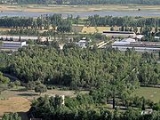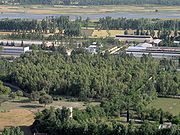
Chakdara
Encyclopedia
Chakdara is a town in Lower Dir District
of Khyber-Pakhtunkhwa. It is located north of Malakand
on the north bank of the Swat River
, in a commanding position near the entrance to Swat District and at the entrance to Lower Dir. It is about 130 km from Peshawar
and 48 km away from Saidu Sharif
.
 The University of Malakand
The University of Malakand
is located in Chakdara, and other important educational institutions are here, including
, Buddhist sites, and Hindu Shahi
forts. The ancient route from Afghanistan
via Nawa Pass and Katgala Pass crosses the Swat River at Chakdara.
The Mughals built a fort here in 1586, occupied in 1895 by the British, who built the present fort in 1896 and were forced to defend it during the Siege of Malakand
in 1897.
At the foot of Damkot Hill at Salami there is an early graveyard. Early settlers buried partially cremated bodies surrounded by everyday utensils. The graves were sealed by large stone slabs.
A Buddhist stupa and monastery of the first century AD were excavated by Ahmad Hasan Dani
in 1962-65. There are some Buddhist carvings at the foot of the hill. During the Hindu Shahi period a fort was built here which was destroyed in the 11th century. In the 19th century the British occupied this hill. Behind Damkot Hill at Chat Pat is the site of a monastery of the late 4th century. The sculpture from this monastery is displayed in Chakdara Museum.
According to another tradition, Gandhāra
is also thought to be the location of the mystical Lake Dhanakosha, birthplace of Padmasambhava
, founder of Tibetan Buddhism. The Kagyu
sect of Tibetan Buddhism identifies the lake with the Alladun Dheri stupa. A spring was said to flow from the base of the stupa to form the lake. Archaeologists have found the stupa but no spring or lake can be identified. Alladun Dehri Stupa was excavated by Dani. Over 500 pieces of Gandhara sculpture were recovered.
Lower Dir District
Lower Dir is one the 24 districts of Khyber Pakhtunkhwa, Pakistan. The district was formed in 1996, when the district of Dir was divided into Upper Dir and Lower Dir.- Administration :...
of Khyber-Pakhtunkhwa. It is located north of Malakand
Malakand District
Malakand District is a district of the province of Khyber Pakhtunkhwa in Pakistan.The District was formed in 1970 as a Provincially Administered Tribal Area, It had previously been a Tribal Area known as the Malakand Protected Area, part of the Malakand Agency...
on the north bank of the Swat River
Swat River
The Swat River is a river in Khyber-Pakhtunkhwa Province, Pakistan. Its source is in the Hindukush Mountains, from where it flows through the Kalam Valley and Swat District...
, in a commanding position near the entrance to Swat District and at the entrance to Lower Dir. It is about 130 km from Peshawar
Peshawar
Peshawar is the capital of Khyber-Pakhtunkhwa and the administrative center and central economic hub for the Federally Administered Tribal Areas of Pakistan....
and 48 km away from Saidu Sharif
Saidu Sharif
-Saidu Sharif:Saidu Sharif is the capital city of Swat District in the Khyber Pakhtunkhwa Province of Pakistan. It is located at 34°45'0N 72°21'0E with an altitude of 939 metres Saidu sharif is traditional seat of government, remains the administrative headquarters of Malakand division .Saidu...
.

University of Malakand
University of Malakand is a higher education institution, established in 2001 which is located at Chakdara in the Dir district of Khyber-Pakhtunkhwa, Pakistan. It is located on the bank of the river Swat.The university is ranked at No...
is located in Chakdara, and other important educational institutions are here, including
- Board of Intermediate and Secondary Education Malakand
- Cadet College
- Degree College for Girls
- Chakdara Fort, which is an academy for the Chitral Scouts.
History
Chakdara has been an important center for the last 3500 years and is littered with remains of the Gandhara grave cultureGandhara grave culture
The Gandhara grave culture emerged ca. 1600 BC, and flourished in Gandhara, Pakistan ca. 1500 BC to 500 BC ....
, Buddhist sites, and Hindu Shahi
Shahi
The Shahi , Sahi, also called Shahiya dynasties ruled one of the Middle kingdoms of India which included portions of the Kabulistan and the old province of Gandhara , from the decline of the Kushan Empire in the 3rd century to the early 9th century...
forts. The ancient route from Afghanistan
Afghanistan
Afghanistan , officially the Islamic Republic of Afghanistan, is a landlocked country located in the centre of Asia, forming South Asia, Central Asia and the Middle East. With a population of about 29 million, it has an area of , making it the 42nd most populous and 41st largest nation in the world...
via Nawa Pass and Katgala Pass crosses the Swat River at Chakdara.
The Mughals built a fort here in 1586, occupied in 1895 by the British, who built the present fort in 1896 and were forced to defend it during the Siege of Malakand
Siege of Malakand
The Siege of Malakand was the 26 July – 2 August 1897 siege of the British garrison in the Malakand region of colonial British India's North West Frontier Province...
in 1897.
Archaeological Sites
Buddhist sculpture of the 1st to 7th centuries from nearby sites and Hindu Shahi artefacts are now displayed at Chakdara Museum.Damkot Hill
The most important site in Chakdara is Damkot Hill. The top of Damkot Hill has been excavated and houses with pottery and jewellery have been discovered. These items are now displayed in the Saidu Sharif Museum.At the foot of Damkot Hill at Salami there is an early graveyard. Early settlers buried partially cremated bodies surrounded by everyday utensils. The graves were sealed by large stone slabs.
A Buddhist stupa and monastery of the first century AD were excavated by Ahmad Hasan Dani
Ahmad Hasan Dani
Professor Ahmad Hasan Dani FRAS, SI, HI , was a Pakistani intellectual, archaeologist, historian, and linguist. He was among the foremost authorities on Central Asian and South Asian archaeology and history. He introduced archaeology as a discipline in higher education in Pakistan and Bangladesh...
in 1962-65. There are some Buddhist carvings at the foot of the hill. During the Hindu Shahi period a fort was built here which was destroyed in the 11th century. In the 19th century the British occupied this hill. Behind Damkot Hill at Chat Pat is the site of a monastery of the late 4th century. The sculpture from this monastery is displayed in Chakdara Museum.
Alladun Dheri
Alladun Dheri, an important Buddhist site, is located 7 km north of Chakdara Bridge near the village of Uchh. According to the Buddhist pilgrim Xuan Zang this site was connected with a legend about Buddha. According to the legend, Buddha changed himself into a great serpent lying dead in the valley in order to save the people from famine. The starving people cut pieces from the body and fed themselves.According to another tradition, Gandhāra
Gandhara
Gandhāra , is the name of an ancient kingdom , located in northern Pakistan and eastern Afghanistan. Gandhara was located mainly in the vale of Peshawar, the Potohar plateau and on the Kabul River...
is also thought to be the location of the mystical Lake Dhanakosha, birthplace of Padmasambhava
Padmasambhava
Padmasambhava ; Mongolian ловон Бадмажунай, lovon Badmajunai, , Means The Lotus-Born, was a sage guru from Oddiyāna who is said to have transmitted Vajrayana Buddhism to Bhutan and Tibet and neighbouring countries in the 8th century...
, founder of Tibetan Buddhism. The Kagyu
Kagyu
The Kagyu, Kagyupa, or Kagyud school, also known as the "Oral Lineage" or Whispered Transmission school, is today regarded as one of six main schools of Himalayan or Tibetan Buddhism, the other five being the Nyingma, Sakya, Jonang, Bon and Gelug...
sect of Tibetan Buddhism identifies the lake with the Alladun Dheri stupa. A spring was said to flow from the base of the stupa to form the lake. Archaeologists have found the stupa but no spring or lake can be identified. Alladun Dehri Stupa was excavated by Dani. Over 500 pieces of Gandhara sculpture were recovered.
Other Sites
Three kilometers from Alladun Dheri Stupa there is the Hindu Shahi fort of Kamal Khan China. It is now in ruins. From this fort a track leads to Nimogram Buddhist Monastery and Stupa. It has three main stupas, which identify three principles of Buddhism; Buddha the teacher, Dharma and Sangha (the Buddhist order). Near Chakdara Bridge there are ruins of the Hindu Shahi Period and stupas at Haibatgram, Top Dara and Landakai.See also
- Lower Swat ValleyLower Swat ValleyThe Lower Swat Valley in Swat and Lower Dir Districts in Pakistan is an area of important archeological sites.The lower valley of the Swat River has been occupied for the last 3000 years. The area between Chakdara Bridge and Saidu Sharif is littered with the remains of pre historic Aryan's Gandhara...
- BadwanBadwanBadwan is a Union Council, situated on the bank of River Swat. It is a part of Adenzai Tehsil of Lower Dir District, Khyber-Pakhtunkhwa. It contains many small villages including Badwan Upper, Badwan Lower, Baghkandi, Safrona, Gadar, Barorri, Leko, Ghwando, Torogato, Swato Banda, Ghazo etc...
- ShawaShawaShawa is a village located in Lower Dir District, Malakand region of Khyber-Pakhtunkhwa. Shawa is located on the road between Chakdara and Asbanr. The village is 5 km away from Chakdara city, which is located near Churchill Piquet on the banks of the Swat River. The population of Shawa is about...
- CHAKDARWAL

